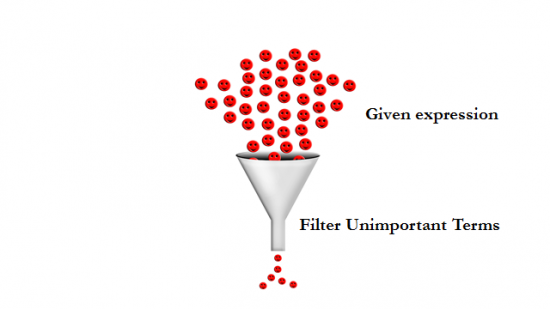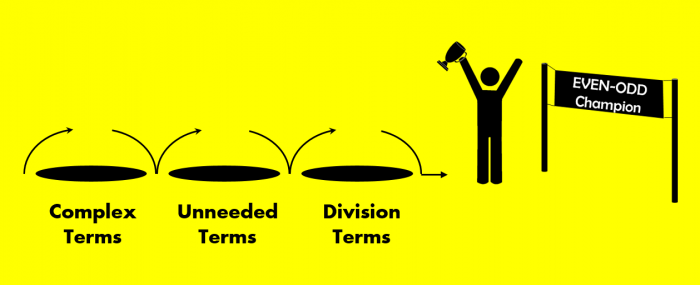When it comes to ‘Even – Odd’, it’s not just an issue on Delhi roads, but also in your GMAT Quant section. Even-Odd numbers is deemed to be among the easier concepts on the GMAT Quant, and yet, come 700+ level questions from this concept, many students get them wrong. Our Subject Matter Experts have closely studied the mistakes that students make in Even-Odd questions – from the doubts they ask in Even-Odd questions in our internal forums, and from the mistakes made by 2000+ students in our recurring Number Properties Live Classroom.

For better understanding, we have outlined in this article:
- 3 primary pitfalls of GMAT Quant Even-Odd questions
- How to avoid these pitfalls
- Illustrative GMAT Number properties (Odd-Even) questions
- Takeaways
- GMAT Number properties ( Even-Odd) practice questions
3 Primary Pitfalls of GMAT Quant Even-Odd Questions
What we have observed is that there are three primary pitfalls that students fall into, in Even-Odd questions:.
- Getting intimidated by complex expressions
- Wasting time on unimportant terms
- Getting stumped in division
1. Getting intimidated by complex expressions
What we mean
A few Even-Odd questions may have scary-looking expressions. For example, consider this question
P1.1 If j is a positive integer, is (j3-27)2(j3+1)3 odd?
Did you feel a bit nervous reading this question? Well, that is the first pitfall that you have to guard against. Because, if you let yourself become nervous, you will:
- Either leave the question without answering
- Or you will panic; panic clouds our ability to think rationally and so, increases our chances of making an error.
-
- For example, in your panic, you may scramble to remember and apply the formula for a3 + b3 on the terms of this expression, and then, realize, much to your dismay, that you’ve complicated the question even further L
So, as you can see, ‘getting intimidated by complex expressions’ is indeed a dangerous pitfall.
What can you do to avoid this pitfall?
The next time you face such a question in GMAT Quant section and notice your heartbeat increasing, take a deep breath and tell yourself,
“Since this is a GMAT Quant question, it can be simplified elegantly.”
This is true! The beauty of official GMAT questions is that no matter how complex they look, they can always be simplified to a couple of cases.

Illustrative Example
So, let’s think through the question we posed above and see how it can be simplified.
1st Simplification
The given expression is (j3-27)2(j3+1)3
You’re probably familiar with the property that the power of a number doesn’t impact the even-odd nature of the number.
- (Even)n, where n is a positive integer = Even
- Similarly, (Odd)n = Odd
So, (j3 – 27)2 will have the same even-odd nature as (j3 – 27). Similarly, (j3 + 1)3 will have the same even-odd nature as (j3+1)
- j3 will have the same even-odd nature as j itself.
So, using this property, we’ve done the first level of simplification: now, we only have to determine the even-odd nature of this, simpler expression: (j-27)(j + 1)
2nd Simplification
The simpler expression is a product of 2 terms: (j – 27) and (j+1)
When will the product of 2 terms be odd? Only if each of the 2 terms are themselves odd. If even one of these terms is even, the product will be even.
So, to answer the question, we need to know: are each of the 2 terms odd?
So, from the earlier situation of dealing with the product as a whole, we are now dealing with individual terms only: (j – 27) and (j + 1)
Getting to the answer
Now, j can either be Even or Odd.
Case 1: j is odd
In this case, j + 1 = Odd + Odd = Even
And j – 27 = Odd – Odd = Even
Since both the terms are Even, the answer in this case will be NO, the given expression in not odd.
Case 2: j is even
In this case, j + 1 = Even + Odd = Odd
And, j – 27 = Even – Odd = Odd
Since both the terms are odd, the answer in this case will be YES, the given expression is odd
So, as you can see, using this step-wise approach, we’ve been able to simplify the question to this:
Is j even?
Takeaway
Use the properties of Even-Odd combinations to simplify scary-looking expressions. Have the confidence that all Even-Odd questions in the GMAT can be easily simplified. Don’t get intimidated by complex expressions in Even-Odd questions and avoid the impulse to search for algebraic formulae to apply on such expressions.
Test Yourself
You’ll know that you’ve learnt this lesson well, if your heart doesn’t skip a beat at the first look of the following question:
P1.2 If X = P*NK + P where N and K are positive integers, is X divisible by 2?
(1) N + KN = 915
(2) P35 + 35P is Even
Solution to this GMAT Number properties odd-even question
2. Wasting time on unimportant terms
What we mean
What we mean by ‘unimportant terms’ is ‘the terms that do not impact the Even- Odd nature of the expression. For example, consider the following question:
P2.1 If a and b are integers, is a + 8b even?
In this expression, the term 8b will be even, irrespective of whether b is even or odd (because, Even*Odd = Even and Even*Even = Even). So, you should focus all your attention on analysing whether a is even or odd, because that is what will get you to the answer.
If you fall into the pitfall of analysing the given information to determine the even-odd nature of b, then you’ll be squandering your most precious resource in the GMAT – Time. Minutes frittered away thus may create a time crunch towards the end of the test, and then, coming under the pressure of the seconds ticking away, you may frantically answer even questions that you know, wrong. So, it is very important to be on strict guard against even a moment spent on unneeded analysis. And, in Even-Odd questions, it’s all too easy to fall into this booby trap.
What can you do to avoid this pitfall?
In order to not waste even a second on the unimportant terms, here are a few pointers that you should use to weed out the unimportant terms in an expression:
- A term of the form (Even number)*(X) will always be even
- In a term of the form (Even number) + X, the (Even number) plays no role in the Even-Odd nature of the term
- In a term of the form (Odd number)*(X), the (Odd number) plays no role in the Even-Odd nature of the term
Example
You’ve already seen an example of the first pointer in Question P2.1
Here’s an example that will show all the three pointers in action
P2.2 If a, b, c and n are integers, is a + 8b + (2n+1)c even?
1st Pointer
The term 8b will always be even, irrespective of the value of b
2nd Pointer
In the given expression, the even term 8b doesn’t impact the even-odd nature of this expression. So, the expression will have the same even-odd nature as the sum a + (2n+1)c
3rd Pointer
In the term (2n+1)c, (2n+1) is an odd number, and so plays no role in the even-odd nature of this term. So, the term (2n+1)c will have the same even-odd nature as c.
So, the expression a + (2n+1)c will have the same even-odd nature as the expression a + c
To some students Pitfall 2 may seem similar to Pitfall 1 because the strategy suggested to avoid Pitfall 2 (the Three Pointers) also leads to simplification of the given expression. However, even though the effect of the strategies suggested in Pitfalls 1 and 2 may be the same, the problems that these strategies tackle are different. In Pitfall 1, the problem is that a student may get intimidated by a difficult-looking expression. In Pitfall 2, on the other hand, the problem is that a student may waste time on analysing terms that do not contribute to the Even-Odd nature of an expression. These are two distinct problems, and so, Pitfalls 1 and 2 are distinct as well.
Takeaway
When you see an expression, first use the Three Pointers to determine the unimportant terms. Do not waste precious time on processing the unimportant terms.

Test Yourself
See how much time you take on this question and if you waste time on any term that doesn’t deserve it:
P2.3 If a, b and n are positive integers such that n = 3a – b3, is n2 + 3 divisible by 2?
(1) a2 – 4b3 – 5 = 0
(2) 3b3 – a2 + 6 = 0
(The detailed discussion of this question is available here)
3. Getting stumped in division
What we mean
If A and B are given to be integers, where A > B and A/B is an integer, can you smoothly work out the relation between the even-odd nature of A, B and the integer A/B?
For example, consider the following question:
P3.1 If A, B and X are integers, X/B is an even integer and XB/(4A+1) is an integer, is XB/(4A+1) odd?
If you don’t have a firm approach to deal with this and similar questions, you’re bound to feel flummoxed, and then you’ll:
- Either give up this question as too difficult
- Or will gingerly try number substitution to see which values of X and B give an even value of X/B, and then with those values of X, try to see if XB/(4A+1) is odd. This approach is time-consuming and error-prone, because you may miss out on some possible cases.
Both possible actions are costly – in terms of lost score points and lost time. So, it is important to not fall prey to such questions.
What can you do to avoid this pitfall?
This pitfall is easily avoided by following the standard approach presented here –
Convert the division equation into a multiplication equation.
Illustrative Example
Let’s illustrate this approach on question P3.1
The division equation that we can write for the terms X/B is:
We can convert this equation into a multiplication equation by multiplying both sides with B. We get:
X = (Even number)*B
–> X is Even (Refer to Pointer (i) in Pitfall 2)
Now, let’s write the division equation for the term (XB/4A+1):
XB/(4A + 1) = integer Z (say)
Converting this equation into a multiplication equation, we get:
–> XB = (4A+1)*(Z)
–> XB has the same Even-Odd nature as Z (because 4A + 1 is odd – Refer to Pointers (ii) and (iii) in Pitfall 2)
Since X is Even, XB is Even
–> Z is Even
So, we see that the given expression will be Even.
Takeaway
In Even-Odd questions that involve division, convert the division equation into multiplication equation.
Test Yourself
P3.2 If x, y and z are positive integers such that x4 y3 = z2, is x9 – y6 odd?
(1) (x4 y3)/(x2 + y2)can be written in the form 4k + 3, where k is a positive integer.
(2) z = x + y
(The detailed discussion of this question is available here)
Conclusion
Even when you know a concept, you might not be able to answer the questions that test advanced application of that concept. In this article, we saw the three pitfalls that many students fall into in Even-Odd questions. If you make a conscious effort to avoid these pitfalls, you’ll find that your ability to answer 700+ level Even-Odd questions will improve significantly. As a happy co-benefit, the time you take to solve the questions will also come down.

If you wish to work further on the 3 pitfalls, please practice the 3 questions provided below.
Wish you enjoy your journey of GMAT Prep and reach a great score on the GMAT!
GMAT Number properties (Even-Odd) Practice Questions
Question 1
Is the product of two integers A and B odd?
(1) A is the number of factors of N, where N is a perfect square and B = A3 -1
(2) A is a product of two consecutive prime numbers and when is added to A, the sum is an odd number.
(The detailed solution of this question is available here)
Question 2
If P and Q are positive integers, is the product 3PQ divisible by 2?
(1) 6Q3 + 2 is an even number
(2) P + 8Q2 is a prime number
(The detailed solution of this question is available here )
Question 3
Is 3a + 2b + 5c even if 0<a<b<c and a, b and c are integers?
(1) 9a+7c is not even
(2) a3*(c-1)2 is odd
(The detailed solution of this question is available here)














